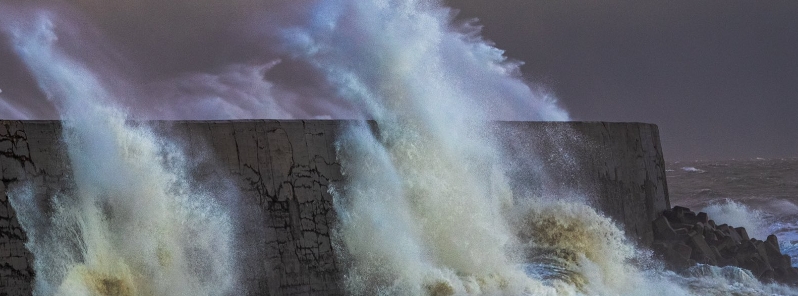Storm Jorge lashes flood-hit parts of Ireland and UK after wettest February on record

Flood-stricken areas in the UK and Ireland faced further disruptions after Storm Jorge brought heavy downpour and strong winds on February 29, 2020. Amid the extremes, the Met Office also announced that the UK just saw its wettest February on record and fifth wettest of any month on record. For the UK, this winter is thus far the fifth wettest and fifth mildest winter season ever.
The worst-hit places were Ironbridge and Bewdley along the Severn River in the West Midlands, as well as West Cowick and Lidgate in East Yorkshire, England. Emergency teams had to repair damaged flood barriers in parts of the West Midlands.
MP Andrew Percy met with Environment Agency officials on Sunday, March 1, and appealed to the government to review the allocation for the flood defense budget.
"We live in a flood risk area, but there's no precedent of it in this area, there's no record of flooding in this area," said Percy.
"There has been a record level of rainfall, but it is becoming more normal and we need to look at how we need to manage flood resources in the country."
He added, "The government is going to have to do a full review of how we deposit flood defense resources."





Furthermore, around 15 rivers in the Midlands, Yorkshire, and Lancashire have recorded their highest levels ever. Devastating photos and videos on social media showed houses entirely inundated in Snaith, East Yorkshire, with some floodwaters as high as kitchen countertops.
"We are just in a dream world at the moment and there are people all over this town exactly the same, it's a nightmare," said resident Catherine Lorryman, who lost her home to floods.
Some 78 residential and commercial properties in the surrounding area have been submerged. Prior to Storm Jorge, thousands of homes and businesses were already flooded by previous storms.
In England alone, more than 3 300 were believed to have been affected by the combined effects of past storms Ciara and Dennis.
Everyone be careful out there. This was a truck being blown over by the wind near Maam Cross in Galway. #StormJorge
whatsapp pic.twitter.com/DLl8Pd1Hom— Donal Doc GolfCentralDaily (@GolfCentralDoc) February 29, 2020
Look at the hut on the right#StormJorge #Mayo pic.twitter.com/frzDWwxojN
— Adrian Weckler (@adrianweckler) February 29, 2020
Meanwhile, parts of Scotland saw showers and strong winds with snow on Sunday morning, while the southern portions saw brighter and chilly conditions.
On a positive note, the Environment Agency revealed that 127 000 properties have been protected by flood defenses for this season. However, the agency still advised citizens to brace themselves for "more frequent periods of extreme weather like this" due to climate change.
In the Republic of Ireland, thousands of homes were left without electricity on Saturday as Jorge approached. The country's western area felt severe winds and heavy rain in particular.
Up to 30 mm (1.2 inches) fell on the weekend, which made flood risks high, according to Met Eireann forecaster Joan Blackburn. She added that while this would not be considered a high amount, the agency still had to issue warnings as it was another amount "flowing into the rivers from all of the lands."
"So that's quite a quantity of water. The flooding is often after the event." She added, "A lot of rivers take awhile for the rainfall to sort of filter down and actually flood."
"Basically, rivers in Connaught, in the Midlands and Clare, they’re still at danger levels. And that rainfall still has to filter down through."
A yellow warning for gale on coastal waters remains for Ireland as of 14:56 UTC on March 2.
#StormJorge rather tame by comparison to the West of the UK and Ireland, but here's Folkestone, Kent today (290220) approaching high tide. pic.twitter.com/2dIm00K3A9
— Kingfisher (@Barbus59) February 29, 2020
Storm Jorge has arrived#stormjorge #wetandwild #weatherwarnings #weather #IrelanDaily #Ireland pic.twitter.com/Ii8R5AA175
— IrelanDaily (@IrelanDaily) February 29, 2020
A total of 74 flood warnings and 126 alerts were still in force for England, while two warnings and four alerts were still in place for Wales as of 14:53 UTC.
Storms this season made February 2020 the wettest February on record for UK, England, Wales, and Northern Ireland, the Met Office announced. It was the second wettest for Scotland, behind the record set in 1990.
In addition, this winter season– which spans from December to February– has been the fifth wettest winter on record for the UK.
"December was slightly wetter than average for the UK overall, just 16% above average, particularly for southern England and East Anglia, which was 30-50% above average," the agency wrote.
"While January was wetter than average across northwest Scotland and drier than average for northeast England and eastern Scotland, and the average for the UK overall."
We can now confirm the latest UK stats…
February 2020
Wettest February on record
5th wettest of ANY month on recordWinter 2019/20
5th wettest Winter on record
5th mildest Winter on recordRead full details in our press release https://t.co/QyVuXLn6g7 pic.twitter.com/LIBJVpcyjO
— Met Office (@metoffice) March 2, 2020
Take a look at what the weather has in store this week with Met Office meteorologist @alexdeakin pic.twitter.com/F6r6cSdbpO
— Met Office (@metoffice) March 2, 2020
Sunshine and showers are expected across the UK by Tuesday, March 3, while a spell of further rain will affect England and Wales mid-week.
Featured image credit: @Leeprin48890181/Twitter

Commenting rules and guidelines
We value the thoughts and opinions of our readers and welcome healthy discussions on our website. In order to maintain a respectful and positive community, we ask that all commenters follow these rules:
We reserve the right to remove any comments that violate these rules. By commenting on our website, you agree to abide by these guidelines. Thank you for helping to create a positive and welcoming environment for all.